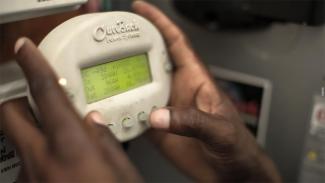Off-grid health facility loads can be categorized into critical and non-critical loads, which helps in attributing the appropriate energy supply source to a particular end-use equipment.
An initial load and energy analysis of an off-grid health facility is a critical component to facilitate the design and operation of energy supply systems. When properly executed, a load analysis can yield valuable insights into facility energy usage that can help reduce energy costs, increase productivity, and protect critical assets.
Types of Loads
Categorizing a facility’s load into contact or no-contact and critical or non-critical portions is essential to estimating a backup power system. Sizing backup power for non-critical loads inevitably leads to a larger, more costly system than necessary. Similarly, uninterruptible power supplies (UPS) must be sized to cover all no-contact loads, but providing a UPS for contact loads will lead to higher system costs with little added benefit.
Non-critical Loads
Non-critical loads are those loads that, if not supplied with power, will not put patients at immediate risk or substantially disrupt facility operations. Air conditioners, in most cases, are an example of a non-critical load.
Critical Loads
Critical loads are normally defined as equipment that is crucial to the operation of the facility. Some common examples include lighting; laboratory equipment; emergency and operating rooms; and information systems and computers. Critical loads are further categorized by their need for high-quality, uninterrupted power.
Contact Critical Loads
Contact critical loads are those that can endure minor fluctuations in voltage and brief loss of power, such as lighting or vaccination refrigeration.
No-Contact Critical Loads
No-contact critical loads are loads for which any interruption in power will result in damage to the equipment or loss of data. Sensitive laboratory instruments, medical equipment such as x-rays, and data acquisition systems are all no-contact critical loads.
End Uses
The end use of a load describes the general purpose or equipment type with which it is associated. The goal of classifying loads by end use is to organize the load inventory and better understand which activities at the facility are most energy intensive. Defining appropriate end-use categories depends on the size of the facility, the diversity of loads found at the facility, the different health-care activities that take place at the facility, and the objectives of the load analysis. End-use categories can be very broad or very specific, depending on the needs and interests of the energy management plan.
Examples of some typical end-use categories include lighting, air conditioning, and office equipment. In these examples, all lighting equipment (e.g., LED bulbs, exam lamps, security lighting) is classified as lighting, all air conditioners, regardless of size or type, are classified under air conditioning, and any computers, printers, fax machines, or even UPSs could be classified as office end-use equipment.
These very basic categories can be broken down further. Lighting can be classified as indoor or outdoor lighting, or by technology. Similarly, it is common to define air conditioners by type (e.g., window, mini-split, ducted units) and capacity (e.g., BTU/hr, tons, kW). Office equipment can be subcategorized by specific equipment type, like computers, printers, etc. Sub-categorizing broad end-use classifications makes a load inventory more versatile; it can be used to present a high-level overview of energy consumption or to estimate the energy savings from targeted measures such as lighting retrofits.
An end-use category may also refer to a specific facility area or function. For example, laboratory loads are often grouped together, although each piece of equipment may serve a very different purpose. It may be useful to differentiate loads between areas used for administration, reception, storage, or treatment.

USAID
